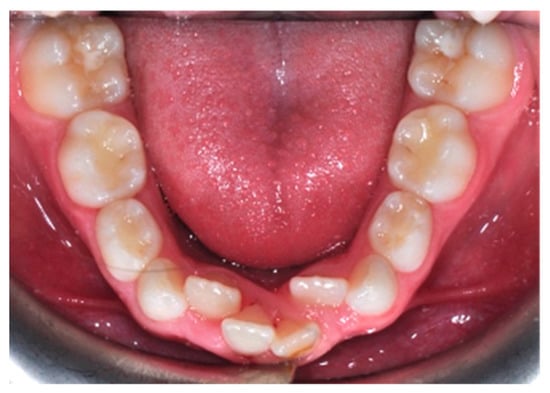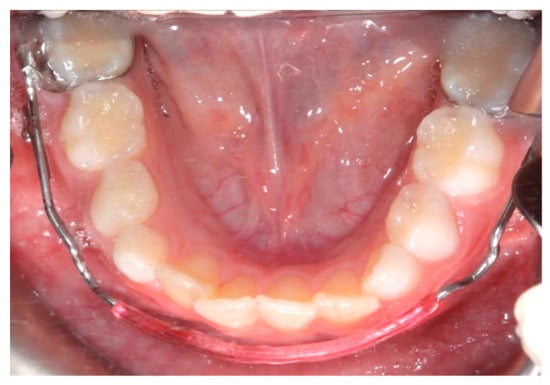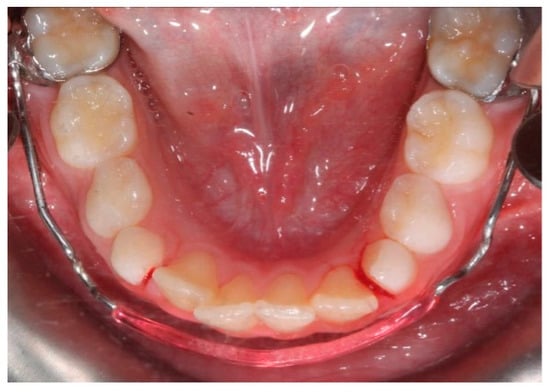
| Version | Summary | Created by | Modification | Content Size | Created at | Operation |
|---|---|---|---|---|---|---|
| 1 | Francesco Inchingolo | -- | 2286 | 2023-05-04 11:46:39 | | | |
| 2 | Conner Chen | Meta information modification | 2286 | 2023-05-06 04:29:41 | | | | |
| 3 | Conner Chen | Meta information modification | 2286 | 2023-05-08 10:58:30 | | |
Video Upload Options
Crowding is the most frequent malocclusion in orthodontics, with a strong hereditary tendency. It already occurs in pediatric age and is mainly hereditary. It is a sign of a lack of space in the arches, and is not self-correcting, but can worsen over time. The main cause of the worsening of this malocclusion is a progressive and physiological decrease in the arch perimeter. An orthodontic treatment cannot ignore the concept of “guide arch”, which concerns the lower arch, because of the objective difficulty in increasing its perimeter; the bone structure of the lower jaw is more compact than that of the upper one. Its expansion, in fact, is limited to a slight vestibularization of the incisors and lateral sectors that may be associated with a limited distalization of the molars. There are various therapeutic solutions available to the orthodontist, and a correct diagnosis through clinical examination, radiographs and model analysis are essential. The decision of how to deal with crowding cannot be separated from an overall assessment of the malocclusion to be treated.
1. Introduction

2. Diagnostic Methods
3. Prophylaxis
4. Treatment



References
- Normando, D.; Almeida, M.A.O.; Quintão, C.C.A. Dental Crowding. Angle Orthod. 2013, 83, 10–15.
- Jadhav, V.; Tiwari, M.; Seegavadi, V.; Kamble, R.; Daigavane, P. A Formula for Estimating the Mesiodistal Width of Permanent Mandibular Central Incisors. J. Datta Meghe Inst. Med. Sci. Univ. 2021, 16, 29–32.
- Rizzo, C.; Di Bartolo, I.; Santantonio, M.; Coscia, M.F.; Monno, R.; De Vito, D.; Ruggeri, F.M.; Rizzo, G. Epidemiological and Virological Investigation of a Norovirus Outbreak in a Resort in Puglia, Italy. BMC Infect. Dis. 2007, 7, 135.
- De Vito, D.; Monno, R.; Nuccio, F.; Legretto, M.; Oliva, M.; Coscia, M.F.; Dionisi, A.M.; Calia, C.; Capolongo, C.; Pazzani, C. Diffusion and Persistence of Multidrug Resistant Salmonella Typhimurium Strains Phage Type DT120 in Southern Italy. BioMed Res. Int. 2015, 2015, 1–8.
- Coscia, M.F.; Monno, R.; Ballini, A.; Mirgaldi, R.; Dipalma, G.; Pettini, F.; Cristallo, V.; Inchingolo, F.; Foti, C.; De Vito, D. Human Papilloma Virus (HPV) Genotypes Prevalence in a Region of South Italy (Apulia). Ann. Dell’istituto Super. Di Sanita 2015, 51, 248–251.
- Paul, S.; Garg, S.; Saraf, B.G.; Sheoran, N.; Chawla, M.; Saji, S.E. Arch Measurements, Bigonial Width, Dental Caries, and Their Effect on Occurrence of Mandibular Incisors Crowding in Early Mixed Dentition Period. Int. J. Clin. Pediatr. Dent. 2021, 14, S57–S62.
- Tartaglia, G.M.; Mapelli, A.; Maspero, C.; Santaniello, T.; Serafin, M.; Farronato, M.; Caprioglio, A. Direct 3D Printing of Clear Orthodontic Aligners: Current State and Future Possibilities. Materials 2021, 14, 1799.
- Maspero, C.; Fama, A.; Cavagnetto, D.; Abate, A.; Farronato, M. Treatment of Dental Dilacerations. J. Biol. Regul. Homeost. Agents 2019, 33, 1623–1627.
- Grainger, R.M. Orthodontic Treatment Priority Index; Vital Health Stat 2; United States Department of Health, Education, and Welfare: Washington, DC, USA, 1967; pp. 1–49.
- Cazzolla, A.P.; Zhurakivska, K.; Ciavarella, D.; Lacaita, M.G.; Favia, G.; Testa, N.F.; Marzo, G.; La Carbonara, V.; Troiano, G.; Lo Muzio, L. Primary Hyperoxaluria: Orthodontic Management in a Pediatric Patient: A Case Report. Spec. Care Dent. 2018, 38, 259–265.
- Lo Russo, L.; Ciavarella, D.; Salamini, A.; Guida, L. Alignment of Intraoral Scans and Registration of Maxillo-Mandibular Relationships for the Edentulous Maxillary Arch. J. Prosthet. Dent. 2019, 121, 737–740.
- Cassano, M.; Russo, G.; Granieri, C.; Ciavarella, D. Modification of Growth, Immunologic and Feeding Parameters in Children with OSAS after Adenotonsillectomy. Acta Otorhinolaryngol. Ital. 2018, 38, 124–130.
- Maspero, C.; Abate, A.; Inchingolo, F.; Dolci, C.; Cagetti, M.G.; Tartaglia, G.M. Incidental Finding in Pre-Orthodontic Treatment Radiographs of an Aural Foreign Body: A Case Report. Children 2022, 9, 421.
- Farronato, M.; Maspero, C.; Abate, A.; Grippaudo, C.; Connelly, S.T.; Tartaglia, G.M. 3D Cephalometry on Reduced FOV CBCT: Skeletal Class Assessment through AF-BF on Frankfurt Plane-Validity and Reliability through Comparison with 2D Measurements. Eur. Radiol. 2020, 30, 6295–6302.
- Ergoren, M.C.; Paolacci, S.; Manara, E.; Dautaj, A.; Dhuli, K.; Anpilogov, K.; Camilleri, G.; Suer, H.K.; Sayan, M.; Tuncel, G.; et al. A Pilot Study on the Preventative Potential of Alpha-Cyclodextrin and Hydroxytyrosol against SARS-CoV-2 Transmission. Acta Bio Med. Atenei Parm. 2020, 91, e2020022.
- Maspero, C. Operculectomy and Spontaneous Eruption of Impacted Second Molars: A Retrospective Study. J. Biol. Regul. Homeost. Agents 2019, 33, 1909–1912.
- Maspero, C.; Cappella, A.; Dolci, C.; Cagetti, M.G.; Inchingolo, F.; Sforza, C. Is Orthodontic Treatment with Microperforations Worth It? A Scoping Review. Children 2022, 9, 208.
- Das, P.J.; Dkhar, W.; Pradhan, A. An Evaluation of Dental Crowding in Relation to the Mesiodistal Crown Widths and Arch Dimensions in Southern Indian Population. J. Clin. Diagn. Res. 2017, 11, TC10–TC13.
- Ciavarella, D.; Monsurrò, A.; Padricelli, G.; Battista, G.; Laino, L.; Perillo, L. Unilateral Posterior Crossbite in Adolescents: Surface Electromyographic Evaluation. Eur. J. Paediatr. Dent. 2012, 13, 25–28.
- Inchingolo, A.M.; Fatone, M.C.; Malcangi, G.; Avantario, P.; Piras, F.; Patano, A.; Di Pede, C.; Netti, A.; Ciocia, A.M.; De Ruvo, E.; et al. Modifiable Risk Factors of Non-Syndromic Orofacial Clefts: A Systematic Review. Children 2022, 9, 1846.
- Brunelle, J.A.; Bhat, M.; Lipton, J.A. Prevalence and Distribution of Selected Occlusal Characteristics in the US Population, 1988–1991. J. Dent. Res. 1996, 75, 706–713.
- Jain, R. Prevalence of Mandibular Anterior Teeth Crowding in Mixed Dentition Subjects Reporting to a University Hospital in Chennai City. Int. J. Dent. Oral Sci. 2019, S3, 6–11.
- Grippaudo, M.M.; Quinzi, V.; Manai, A.; Paolantonio, E.G.; Valente, F.; La Torre, G.; Marzo, G. Orthodontic Treatment Need and Timing: Assessment of Evolutive Malocclusion Conditions and Associated Risk Factors. Eur. J. Pediatr. Dent. 2020, 21, 203–208.
- Farronato, M.; Boccalari, E.; Del Rosso, E.; Lanteri, V.; Mulder, R.; Maspero, C. A Scoping Review of Respirator Literature and a Survey among Dental Professionals. Int. J. Environ. Res. Public Health 2020, 17, 5968.
- Leighton, B.C. The Early Signs of Malocclusion. Eur. J. Orthod. 2007, 29, i89–i95.
- Jain, R. Association Of Mandibular Arch Crowding And Vertical Growth Pattern—A Retrospective Study. Int. J. Dent. Oral Sci. 2021, 8, 4096–4100.
- Satra, P.; Vichare, G.; Bhosale, V. Relationship of Maxillary and Mandibular Effective Base Length, Arch Length and Dental Crowding in Different Vertical Growth Pattern. APOS 2022, 12, 108–114.
- Singh, S.; Shivaprakash, G. To Evaluate the Correlation Between Skeletal and Dental Parameters to the Amount of Crowding in Class II Div. 1 Malocclusions. J. Clin. Diagn. Res. 2017, 11, ZC22–ZC27.
- Pasciuti, E.; Coloccia, G.; Inchingolo, A.D.; Patano, A.; Ceci, S.; Bordea, I.R.; Cardarelli, F.; Di Venere, D.; Inchingolo, F.; Dipalma, G. Deep Bite Treatment with Aligners: A New Protocol. Appl. Sci. 2022, 12, 6709.
- Di Ventura, A.; Lanteri, V.; Farronato, G.; Gaffuri, F.; Beretta, M.; Lanteri, C.; Cossellu, G. Three-Dimensional Evaluation of Rapid Maxillary Expansion Anchored to Primary Molars: Direct Effects on Maxillary Arch and Spontaneous Mandibular Response. Eur. J. Pediatr. Dent. 2019, 20, 38–42.
- Inchingolo, A.D.; Carpentiere, V.; Piras, F.; Netti, A.; Ferrara, I.; Campanelli, M.; Latini, G.; Viapiano, F.; Costa, S.; Malcangi, G.; et al. Orthodontic Surgical Treatment of Impacted Mandibular Canines: Systematic Review and Case Report. Appl. Sci. 2022, 12, 8008.
- Tepedino, M.; Iancu-Potrubacz, M.; Ciavarella, D.; Masedu, F.; Marchione, L.; Chimenti, C. Expansion of Permanent First Molars with Rapid Maxillary Expansion Appliance Anchored on Primary Second Molars. J. Clin. Exp. Dent. 2018, 10, e241–e247.
- Antoszewska-Smith, J.; Bohater, M.; Kawala, M.; Sarul, M.; Rzepecka-Skupień, M. Treatment of Adults with Anterior Mandibular Teeth Crowding: Reliability of Little’s Irregularity Index. Int. J. Dent. 2017, 2017, 5057941.
- Persson, M.; Al-Taai, N.; Pihlgren, K.; Westerlund, A. Early Extractions of Premolars Reduce Age-Related Crowding of Lower Incisors: 50 Years of Follow-Up. Clin. Oral Investig. 2022, 26, 4525–4535.
- Ciavarella, D.; Tepedino, M.; Chimenti, C.; Troiano, G.; Mazzotta, M.; Foschino Barbaro, M.P.; Lo Muzio, L.; Cassano, M. Correlation between Body Mass Index and Obstructive Sleep Apnea Severity Indexes—A Retrospective Study. Am. J. Otolaryngol. 2018, 39, 388–391.
- Troiano, G.; Dioguardi, M.; Cocco, A.; Zhurakivska, K.; Ciavarella, D.; Muzio, L.L. Increase the Glyde Path Diameter Improves the Centering Ability of F6 Skytaper. Eur. J. Dent. 2018, 12, 089–093.
- Inchingolo, A.D.; Patano, A.; Coloccia, G.; Ceci, S.; Inchingolo, A.M.; Marinelli, G.; Malcangi, G.; Montenegro, V.; Laudadio, C.; Pede, C.D.; et al. The Efficacy of a New AMCOP® Elastodontic Protocol for Orthodontic Interceptive Treatment: A Case Series and Literature Overview. Int. J. Environ. Res. Public Health 2022, 19, 988.
- Ciavarella, D.; Parziale, V.; Mastrovincenzo, M.; Palazzo, A.; Sabatucci, A.; Suriano, M.M.; Bossù, M.; Cazzolla, A.P.; Lo Muzio, L.; Chimenti, C. Condylar Position Indicator and T-Scan System II in Clinical Evaluation of Temporomandibular Intracapsular Disease. J. Cranio-Maxillofac. Surg. 2012, 40, 449–455.
- Cianci, C.; Pappalettera, G.; Renna, G.; Casavola, C.; Laurenziello, M.; Battista, G.; Pappalettere, C.; Ciavarella, D. Mechanical Behavior of PET-G Tooth Aligners Under Cyclic Loading. Front. Mater. 2020, 7, 104.
- Inchingolo, A.M.; Malcangi, G.; Costa, S.; Fatone, M.C.; Avantario, P.; Campanelli, M.; Piras, F.; Patano, A.; Ferrara, I.; Di Pede, C.; et al. Tooth Complications after Orthodontic Miniscrews Insertion. Int. J. Environ. Res. Public Health 2023, 20, 1562.
- De Vito, D.; Zullo, M.J.; Benincasa, C.; Aiello, E.; Giacomello, M.S.; Mortellaro, C.; Greco Lucchina, A. Facial Mask and Plexiglass Box: A Critical Overview on the Current Strategies to Protect Patients from COVID-19 Infection. J. Biol. Regul. Homeost. Agents 2021, 35, 139–145.
- De Vito, D.; Di Ciaula, A.; Palmieri, V.O.; Trerotoli, P.; Larocca, A.M.V.; Montagna, M.T.; Portincasa, P. Reduced COVID-19 Mortality Linked with Early Antibodies against SARS-CoV-2, Irrespective of Age. Eur. J. Intern. Med. 2022, 98, 77–82.
- Raucci, G.; Pachêco-Pereira, C.; Elyasi, M.; d’Apuzzo, F.; Flores-Mir, C.; Perillo, L. Predictors of Postretention Stability of Mandibular Dental Arch Dimensions in Patients Treated with a Lip Bumper during Mixed Dentition Followed by Fixed Appliances. Angle Orthod. 2017, 87, 209–214.
- Coloccia, G.; Inchingolo, A.D.; Inchingolo, A.M.; Malcangi, G.; Montenegro, V.; Patano, A.; Marinelli, G.; Laudadio, C.; Limongelli, L.; Di Venere, D.; et al. Effectiveness of Dental and Maxillary Transverse Changes in Tooth-Borne, Bone-Borne, and Hybrid Palatal Expansion through Cone-Beam Tomography: A Systematic Review of the Literature. Medicina 2021, 57, 288.
- Griswold, O.; Li, C.; Orr, J.; Boucher, N.; Shah, S.; Chung, C.-H. Lip Bumper Therapy Does Not Influence the Sagittal Mandibular Incisor Position in a Retrospective CBCT Study. J. Clin. Med. 2022, 11, 6032.
- Freitas, K.M.S.; Massaro, C.; Miranda, F.; de Freitas, M.R.; Janson, G.; Garib, D. Occlusal Changes in Orthodontically Treated Subjects 40 Years after Treatment and Comparison with Untreated Control Subjects. Am. J. Orthod. Dentofac. Orthop. 2021, 160, 671–685.
- Nakhjavani, Y.B.; Nakhjavani, F.B.; Jafari, A. Mesial Stripping of Mandibular Deciduous Canines for Correction of Permanent Lateral Incisors. Int. J. Clin. Pediatr. Dent. 2017, 10, 229–233.
- Verma Comparative Evaluation of Stability of Mandibular Anterior Crowding Correction Done with Two Different Treatment Protocols: A Retrospective Study. Available online: https://www.jioh.org/article.asp?issn=0976-7428;year=2022;volume=14;issue=2;spage=189;epage=194;aulast=Verma (accessed on 24 January 2023).
- Mahmoudzadeh, M.; Mirzaei, H.; Farhadian, M.; Mollabashi, V.; Khosravi, M. Comparison of Anterior Crowding Relapse Tendency in Patients Treated with Incisor Extraction, Premolar Extraction, and Nonextraction Treatment. J. World Fed. Orthod. 2018, 7, 61–65.
- Berbert, M.; Cotrin, P.; de Oliveira, R.G.; de Oliveira, R.G.; Valarelli, F.P.; de Freitas, M.R.; Freitas, K.M.S. The Influence of 3x3 Bonded Retainer on Anterior Crowding Relapse in Mandibular Incisor Extraction Cases. Dent. Press J. Orthod. 2021, 26, e212081.
- Freitas, K.M.S.; Massaro, C.; Miranda, F.; de Freitas, M.R.; Janson, G.; Garib, D. Occlusal Changes in Orthodontically Treated Subjects 40 Years after Treatment and Comparison with Untreated Control Subjects. Am. J. Orthod. Dentofac. Orthop. 2021, 160, 671–685.
- Mahmoudzadeh, M.; Mirzaei, H.; Farhadian, M.; Mollabashi, V.; Khosravi, M. Comparison of Anterior Crowding Relapse Tendency in Patients Treated with Incisor Extraction, Premolar Extraction, and Nonextraction Treatment. J. World Fed. Orthod. 2018, 7, 61–65.




